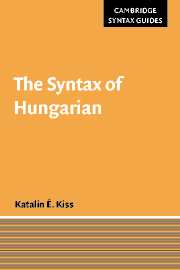Book contents
1 - Introduction
Published online by Cambridge University Press: 06 July 2010
Summary
Genealogy, areal distribution
Hungarian is a Finno-Ugric language. The Finno-Ugric languages and the practically extinct Samoyed languages of Siberia constitute the Uralic language family. Within the Finno-Ugric family, Hungarian belongs to the Ugric branch, together with Mansy, or Vogul, and Khanty, or Ostyak, spoken by a few thousand people in western Siberia. The family also has:
a Finnic branch, including Finnish (5 million speakers) and Estonian (1 million speakers);
a Sami or Lappish branch (35 000 speakers); as well as
a Mordvin branch, consisting of Erzya (500 000 speakers) and Moksha (250 000 speakers);
a Mari or Cheremis branch (550 000 speakers); and
a Permi branch, consisting of Udmurt or Votyak (500 000 speakers) and Komi or Zuryen (350 000 speakers).
Hungarian, Finnish and Estonian are state languages; Sami is spoken in northern Norway, Sweden and Finland, whereas the Mordvin, Mari, and Permi languages are spoken in the European territories of Russia.
Hungarian is spoken in Central Europe. It is the state language of Hungary, but the area where it is a native language also extends to the neighboring countries. In Hungary it has 10 million speakers, in Romania 2 million speakers, in Slovakia 700 000 speakers, in Yugoslavia 300 000 speakers, in Ukraine 150 000 speakers. There is also a Hungarian minority in Croatia, Slovenia, and Austria, and a considerable diaspora in Western Europe, North America, South America, Israel, and Australia.
- Type
- Chapter
- Information
- The Syntax of Hungarian , pp. 1 - 7Publisher: Cambridge University PressPrint publication year: 2002

